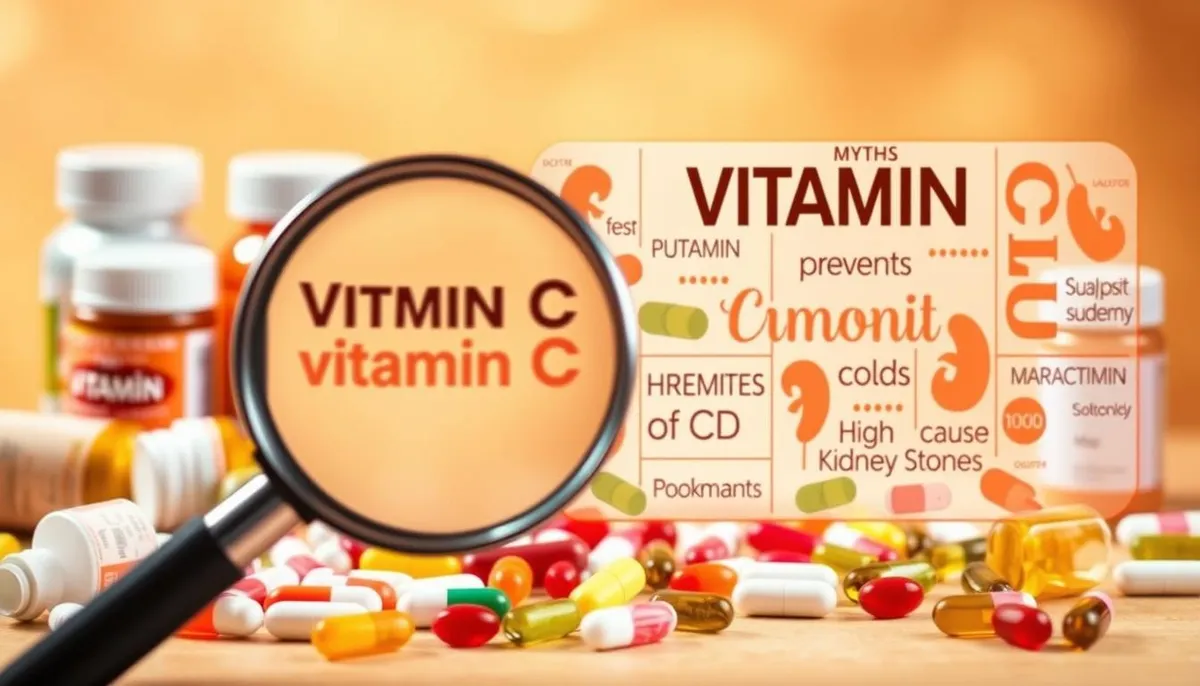Welcome to an evidence-based exploration of how essential nutrients connect with healthy aging. Many people overlook the profound role certain compounds play in extending our healthspan.
While this essential nutrient has been known for centuries as a cure for scurvy, modern science reveals its deeper effects on cellular aging and disease prevention. The connection goes far beyond basic nutrition.

Recent research published in The Journal of Physiological Sciences (2024) shows that nutrient levels directly associate with lifespan in multiple animal models. Clinical studies demonstrate lower blood levels in middle-aged and older adults compared to younger populations.
A major 16-year prospective study in China found remarkable results. Individuals with higher blood levels were 25% less likely to die from any cause. They also showed significantly lower risks for both heart disease and cancer deaths.
This comprehensive guide examines scientific research and practical applications. You’ll discover how proper nutrition works at the cellular level to combat aging. We’ll cover optimal intake strategies and daily implementation methods.
The information comes from peer-reviewed research and clinical evidence. Whether you’re new to longevity science or already familiar with anti-aging strategies, this article offers valuable insights for enhancing well-being.
Key Takeaways
- Essential nutrient levels show direct correlation with lifespan extension in scientific studies
- Modern research reveals cellular benefits beyond traditional understanding
- Higher blood levels associate with 25% lower mortality risk in long-term studies
- Proper nutrition supports reduced risks for heart disease and cancer
- This guide covers molecular mechanisms to practical implementation strategies
- All information grounded in peer-reviewed research and clinical evidence
- Strategies can be immediately applied to enhance overall well-being
The Promise of Vitamin C in Defying Aging
Cutting-edge research is transforming our understanding of how specific compounds influence the aging process. Animal studies provide compelling evidence about nutrient deficiencies and lifespan.
Research using specialized mouse models revealed fascinating results. When animals received minimal amounts that prevented scurvy but maintained deficiency conditions, their lifespans shortened significantly.
Innovative Health Strategies Inspired by Blueprint Bryan Johnson
Modern wellness pioneers have developed systematic approaches to aging. These comprehensive protocols treat nutrients as foundational elements rather than basic supplements.
The Blueprint methodology combines high-quality supplementation with detailed biomarker tracking. This evidence-based approach ensures optimal results for your body’s needs.
Premium Supplements for a Healthier Future
Specialized platforms offer access to formulations designed for maximum bioavailability. These products go beyond typical over-the-counter options in purity and effectiveness.
Longevity-supplement.com connects you with cutting-edge health insights and premium products. Starting your journey toward enhanced well-being begins with understanding which supplements truly make a difference.
Embracing these innovative health strategies requires commitment to quality and consistency. The potential rewards include significantly improved quality of life and extended healthspan.
Understanding Vitamin C: Beyond Scurvy Prevention
While scurvy prevention put this essential compound on the map, its true biological significance runs much deeper. Known scientifically as ascorbic acid, it acts as a powerful, water-soluble antioxidant in the body.
This nutrient neutralizes harmful molecules called reactive oxygen species. This action protects our cells from damage that can accelerate aging.
Physiological Functions and Antioxidant Properties
Ascorbic acid serves as a critical cofactor for many enzymatic reactions. These processes are vital for creating collagen, regulating neurotransmitters, and controlling gene expression.
The reactions fall into two main categories. They involve iron-containing dioxygenases and copper-containing monooxygenases. Both are essential for maintaining cellular health.
This compound even influences epigenetics. It enables processes like DNA and histone demethylation, which turn genes on or off.
It also works with other nutrients. The acid enhances iron absorption from food and helps recycle vitamin E, demonstrating powerful synergy.
Healthy blood levels are around 50 µM. Levels dropping below 11 µM significantly increase disease risk. Understanding these mechanisms shows why optimal intake is crucial for long-term health, not just avoiding deficiency.
Exploring Vitamin C and Longevity: Insights from Scientific Studies
Groundbreaking population research provides some of the strongest evidence for the connection between a specific nutrient and living longer. These large-scale investigations track groups of people for many years.
They look for patterns between health metrics and long-term outcomes. This approach helps scientists move from theory to real-world evidence.
Review of Key Research Findings
A major 16-year project in China offers compelling data. It followed nearly 1,000 healthy adults, starting when they were between 53 and 84 years old.
Researchers measured their initial nutrient levels. They then tracked the group’s health for over a decade and a half.
The results were striking. Individuals with the highest baseline blood concentrations were 25% less likely to die from any cause compared to those with the lowest levels.
| Participant Group (by Blood Level Quartile) | All-Cause Mortality Risk | Cardiovascular Disease Death Risk | Cancer Death Risk |
|---|---|---|---|
| Highest Quartile | Significantly Lower | Reduced | Reduced |
| Lowest Quartile | Baseline Reference | Baseline Reference | Baseline Reference |
Further analysis showed protection against the two leading causes of death. The benefit applied to both heart disease and cancer mortality.
Animal research supports these human findings. Studies in special mice and even primitive worms show that proper nutrient status can extend lifespan.
This consistent pattern across different species strengthens the scientific conclusion. Maintaining optimal levels is a practical strategy for healthier aging.
The Antioxidant Power: How Vitamin C Reduces Oxidative Stress
Understanding how antioxidants combat cellular stress reveals powerful strategies for healthy aging. Oxidative stress occurs when harmful molecules overwhelm your body’s natural defenses.
This imbalance damages critical components throughout your system. Protecting against this damage is essential for maintaining vibrant health.

Mechanisms of Free Radical Scavenging
Ascorbic acid serves as an electron donor to neutralize reactive oxygen species. This unique chemical structure allows it to protect your cells from damage.
Research shows this nutrient reduces markers of oxidative stress in various situations. People exposed to environmental toxins benefit from its protective effects.
Role in DNA Repair and Cellular Health
The antioxidant power extends to protecting your genetic material. It helps prevent DNA damage in rapidly dividing cells throughout your body.
Studies demonstrate this compound activates enzymes that maintain telomeres. These protective caps on chromosomes serve as important markers of biological aging.
By supporting DNA repair mechanisms, this approach addresses aging at its most fundamental level. The benefits extend from brain cells to skin cells systemically.
Vitamin C in Disease Prevention and Chronic Health Conditions
Research reveals a powerful link between nutrient status and the prevention of major chronic illnesses. Studies consistently show that individuals with various conditions have significantly lower blood concentrations.
This pattern suggests a protective role against disease development, not just a consequence of being sick.
Impact on Cardiovascular, Respiratory, and Cancer Risks
The evidence spans multiple body systems. In cardiovascular health, deficient plasma levels are tied to significantly higher odds of coronary artery disease.
For respiratory function, patients with COPD have lower levels. A meta-analysis found that daily supplementation with 400 mg led to measurable improvements in their breathing.
The protective effect against cancer is particularly striking. European research connected higher blood concentrations with a substantially lower risk of lung cancer and pneumonia.
Gastrointestinal studies are equally compelling. For each small increase in blood levels, stomach cancer risk dropped. People with normal levels saw a 27% overall reduction compared to those with the lowest concentrations.
Similarly, women with the highest intake before a breast cancer diagnosis were 25% less likely to die from the disease.
| Health Condition | Patient Blood Levels (µM) | Key Protective Effect |
|---|---|---|
| Chronic Kidney Disease (on hemodialysis) | 7.2 ± 3.9 (post-treatment) | Levels approach scurvy, highlighting critical need |
| Chronic Obstructive Pulmonary Disease (COPD) | 31.2 ± 13.9 | 400 mg daily improves respiratory function |
| Stomach Cancer Prevention | Normal vs. Low Concentration | 27% overall risk reduction |
| Breast Cancer Mortality | Highest vs. Lowest Intake | 25% lower mortality risk |
For patients managing chronic conditions, optimizing this nutrient status is a crucial adjunct therapy. It represents a cornerstone of a comprehensive preventive health strategy.
Dietary Sources and Supplementation Strategies
Getting the right amount of this essential nutrient into your system requires smart choices about what you eat and whether to supplement. Official guidelines suggest 95-110 mg per day to prevent deficiency, but research for healthy aging often points toward higher daily amounts.
Humans have a unique biological need. A genetic mutation means we must get this compound from external sources. This makes your daily intake absolutely essential for maintaining health.
Optimal Daily Vitamin C Intake Recommendations
While the baseline dietary intake is well-established, studies exploring enhanced well-being use much larger amounts. Modest doses of 500 mg daily have shown cardiovascular benefits.
High-dose therapy, using 1,000-2,000 mg per day, appears in numerous clinical trials with positive outcomes. You can find your personal optimal dose using the “bowel tolerance” method.
Food Versus Supplement: What Works Best?
Rich food sources include citrus fruits, berries, bell peppers, and leafy greens. Eating these foods provides the nutrient alongside other beneficial compounds like flavonoids.
Supplementation offers convenience and the ability to reach therapeutic levels that are difficult to achieve through food alone. A combined approach often yields the best results.
Recent science has debunked old concerns. High-dose supplementation is not linked to kidney stones or injury. For best absorption, spread your intake throughout the day.
Clinical Studies and Evidence on Vitamin C Efficacy
Meta-analyses combining multiple studies offer compelling evidence for ascorbic acid’s benefits. These comprehensive reviews pool data from numerous clinical trials, creating the strongest scientific validation available.
Insights from Recent Trials and Meta-Analyses
One major analysis of 44 trials demonstrated consistent improvement in endothelial function. This effect was particularly strong in people with higher cardiovascular risk.
Another review found that adding over one gram daily at illness onset significantly reduced symptom duration and severity. The immune benefits were measurable and consistent across populations.
Bone health research reveals equally impressive results. Higher intake was associated with a remarkable 33% lower osteoporosis risk. This included reduced fracture rates and improved bone density.
Understanding Long-Term Outcomes in Aging
Studies tracking people for decades provide the most compelling evidence. Maintaining optimal nutrient levels throughout life translates to measurable health benefits.
Recent research establishes a positive correlation between intake and telomere length. This biomarker of biological aging predicts both lifespan and healthspan.
The consistency of findings across different study designs strengthens confidence in these approaches. While more research is valuable, existing evidence already supports maintaining good levels as part of a health-focused lifestyle.
Innovative Approaches to Longevity and Health Optimization
Modern science uncovers epigenetic mechanisms where this essential compound directly affects gene expression patterns. These molecular switches control which genes activate without altering your DNA code.
The nutrient participates in DNA demethylation and histone regulation. This influences your biological age—how old your cells function versus your chronological years.
| Epigenetic Mechanism | Biological Impact | Health Outcome |
|---|---|---|
| DNA Demethylation | Activates youth-associated genes | Enhanced cellular repair |
| Histone Modification | Improves gene accessibility | Reduced inflammation |
| RNA Regulation | Optimizes protein production | Better metabolic function |
Research shows this approach modulates entire metabolic and immune pathways. It alleviates endoplasmic reticulum stress, which contributes to aging when dysfunctional.
These epigenetic effects explain the broad impact on well-being. Comprehensive protocols now integrate this strategy to address multiple aging pathways simultaneously for optimal life quality.
Practical Tips for Incorporating Vitamin C into Your Daily Routine
Simple, consistent practices make it easy to maintain optimal nutrient status throughout your life. Start your morning with citrus fruits or a quality supplement during breakfast for better absorption.
Designing a Balanced Diet and Supplement Regimen
Build meals around colorful produce like bell peppers and berries. These foods provide essential compounds alongside complementary nutrients.
Consider your personal needs when planning supplementation. Age, gender, and health status all influence requirements.
| Personal Factor | Impact on Needs | Recommended Adjustment |
|---|---|---|
| Smoking Status | Significantly increases requirements | Add 35 mg daily |
| Physical Activity Level | Moderate increase needed | Consider divided dosing |
| Chronic Health Conditions | May deplete levels faster | Monitor blood levels regularly |
Lifestyle Adjustments for Maximum Benefits
Spread your daily intake across multiple meals. This approach maintains stable blood concentrations throughout the day.
Track your dietary choices and how you feel. Consistency matters more than perfection for long-term benefits.
Monitor your progress through simple observations. Improved immune function and skin health indicate optimal status.
Case Studies: Success Stories in Longevity Enhancement
The most inspiring evidence comes from individuals who have successfully enhanced their well-being through targeted approaches. These real-life examples make scientific findings tangible and relatable.
Real-Life Experiences and Transformation Narratives
Research involving elderly women aged 70-84 revealed striking differences. Those maintaining optimal blood nutrient levels showed significantly better physical performance.
Their muscle strength measurements exceeded peers with deficient concentrations. This translated to improved daily function and reduced frailty scores.
One compelling study followed breast cancer survivors. Women with the highest pre-diagnosis intake experienced 25% better survival rates. Their commitment to nutritional optimization paid remarkable dividends.
| Participant Group | Intervention | Measurable Outcomes |
|---|---|---|
| Elderly Women (70-84 years) | Maintained optimal blood levels | Enhanced muscle strength and physical performance |
| Breast Cancer Patients | High pre-diagnosis intake | 25% lower mortality risk |
| Frailty Management Patients | Supplementation protocol | Reduced frailty severity scores |
These stories demonstrate that nutritional optimization works at any age. Even people in their seventies achieved measurable health improvements.
The evidence clearly shows it’s never too late to benefit from proper nutrient status. These success stories align perfectly with broader scientific findings.
Exploring the Intersection of Vitamin C and Epigenetics
Epigenetic research reveals how dietary compounds can directly influence our cellular programming. This nutrient serves as a cofactor for enzymes that modify genetic activity without altering the DNA sequence itself.
These mechanisms involve removing methyl groups from DNA and histones. This process effectively activates genes that support healthy aging and cellular function.
Influence on Bone Health and Collagen Formation
Ascorbic acid plays a crucial role in bone development through epigenetic regulation. Studies show it enables proper osteoblast formation, the cells responsible for building new bone tissue.
The compound is essential for collagen synthesis throughout the body. It stabilizes the collagen structure in bones, skin, and connective tissues.
Research demonstrates that deficiency leads to bone abnormalities through disrupted gene expression. Supplementation reverses these issues by restoring proper epigenetic signaling.
This nutrient’s impact extends to skin health by supporting collagen production. The epigenetic effects also influence immune system development and metabolic regulation.
Understanding these mechanisms explains the wide-ranging benefits for overall health. The compound literally reprograms how genes function to promote vitality.
Addressing Common Myths and Misconceptions about Vitamin C
Common misunderstandings about certain nutrients often stem from outdated research or incomplete information. Let’s clarify some persistent myths surrounding this essential compound.
Many people worry that high-dose supplementation causes kidney stones. Recent comprehensive studies show no association between excess intake and kidney injury. The oxalate concern has been largely debunked.

Cancer prevention claims also need clarification. While some studies show no effect on incidence, others demonstrate benefits. The relationship depends on baseline status and cancer type.
The “more is always better” approach doesn’t hold true. Benefits have practical limits, and individual responses vary based on genetics and health status.
| Myth | Fact | Key Evidence |
|---|---|---|
| Causes kidney stones | No association with kidney injury | Recent comprehensive studies |
| Prevents all cancers | Complex, type-dependent relationship | Mixed study results |
| More always equals better | Practical limits to benefits | Individual response variation |
| Cure-all for infections | Supports immune function | Reduces duration when taken early |
Understanding these distinctions helps make informed decisions about vitamin supplementation. Separating facts from myths prevents unrealistic expectations while maintaining appropriate health strategies.
Conclusion
The journey toward extended healthspan becomes clearer when we examine specific nutritional factors. Throughout this exploration, compelling evidence demonstrates how proper nutrient status supports cellular health and aging processes.
Maintaining optimal vitamin levels—well above deficiency prevention—associates with longer lifespan and reduced disease risk. The benefits extend across cardiovascular, immune, and bone health systems.
While no single compound reverses aging, consistent research confirms its crucial role in healthy longevity. We encourage assessing your current intake from both diet and supplements.
Remember that nutrient optimization is one component of a comprehensive strategy. It’s never too early or late to prioritize these health factors.
Your journey toward a longer, healthier life involves informed decisions. Thank you for exploring this vital connection between nutrition and vitality.
FAQ
How does ascorbic acid actually help with aging?
This nutrient acts as a powerful antioxidant, fighting oxidative stress that damages cells over time. By protecting your DNA and supporting collagen formation, it helps maintain healthier skin and stronger bones, which are key factors in the aging process.
Can getting enough of this nutrient from food really make a difference in my long-term health?
Absolutely. A diet rich in fruits and vegetables like oranges, bell peppers, and broccoli provides not only this essential compound but also a symphony of other beneficial nutrients. Studies, including those from sources like the Proc Natl Acad Sci, suggest that consistent dietary intake is associated with better health outcomes as we age.
I’ve heard about high-dose supplementation. Is more always better?
A> Not necessarily. While adequate levels are crucial for immune function and disease prevention, the body excretes what it doesn’t use. Most research indicates that meeting the recommended daily intake—whether through food or a standard supplement—is what’s most strongly linked to positive effects on longevity, rather than megadoses.
Are there specific groups of people who need to pay closer attention to their intake?
A> Yes, indeed. Older adults, smokers, and individuals with certain chronic conditions may have higher requirements or lower blood levels. For these populations, paying close attention to dietary intake or considering supplementation under a doctor’s guidance can be particularly important for maintaining health.
How does this antioxidant connect to preventing serious diseases?
A> Its role in reducing oxidative stress is a major player. By neutralizing free radicals, it helps protect your cardiovascular system and may lower the risk of some chronic illnesses. While it’s not a magic bullet, ensuring sufficient levels is a proactive step in a comprehensive health strategy.
RelatedRelated articles



